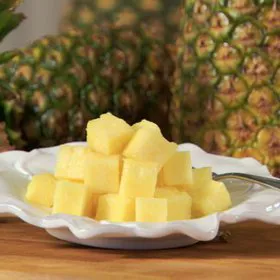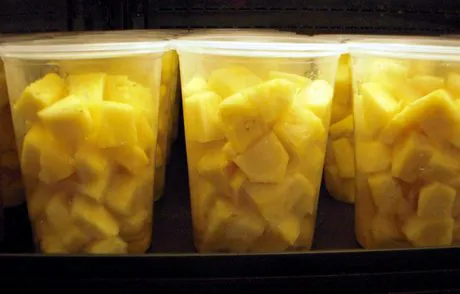 Pineapple (Ananas comosus) is one of the most well-liked tropical fruits for its nutritive characteristics, juicy and tasty flesh. Fresh-cut pineapple is more convenient for the consumer, because the thick peel and inedible crown are removed during fresh-cut processing. However, the process of fruit peeling and cutting increases the metabolic activity and enzymatic processes that are responsible of fruit deterioration, tissue browning, softening, decay, off-flavours and microbial growth, and reduce the shelf-life of fresh-cut pineapple.
Pineapple (Ananas comosus) is one of the most well-liked tropical fruits for its nutritive characteristics, juicy and tasty flesh. Fresh-cut pineapple is more convenient for the consumer, because the thick peel and inedible crown are removed during fresh-cut processing. However, the process of fruit peeling and cutting increases the metabolic activity and enzymatic processes that are responsible of fruit deterioration, tissue browning, softening, decay, off-flavours and microbial growth, and reduce the shelf-life of fresh-cut pineapple.Edible coating is defined as edible material (protein, polysaccharide or lipid) that is used as a thin layer on the surface of foods. It can be applied both to provide a selective barrier to chemical, physical, and biological agents, and to preserve fresh-cut vegetables and fruits improving textural and mechanical properties.
Several studies have been done to determine the effects of polysaccharide-based edible coating on fresh-cut fruits, such as mango, papaya, pear, and banana, while the information of edible coatings on fresh-cut pineapple is limited. Currently, among the polysaccharide-based coatings, alginate and gellan are interesting polymers. The former is obtained from marine algae, the latter is obtained from the bacterium Sphingomonas elodea.
Furthermore, several studies have been done to optimize the edible coatings formulations for vegetables and fruits. The optimization of edible coating was determined using the Response Surface Methodology (RSM). RSM methodology is a collection of mathematical and statistical techniques for building models, designing experiments, searching the optimum conditions and evaluating the effects of factors. The response of interest is influenced by several variables and the objective is to optimize the response. The relationship between the response and a set of independent variables is determined by the mathematical model called regression model.
The researchers, Azarakhsh et al. (2012), have done a study with RSM to optimize the alginate and gellan-based edible coatings formulations for fresh-cut pineapple based on weight loss, firmness and respiration rate of the fresh-cut coated pineapple.

The study
For the study, fresh pineapples were purchased from Pasar Borong Selangor (Malaysia). The maturity stage of fruits was stage 5 according to the Malaysian standard by Federal Agricultural Marketing Authority (2004). For the formulations of edible coatings, the following compounds were used. Sodium alginate and gellan gum were used as polysaccharide-based edible coatings. Glycerol was applied for plasticizer, sunflower oil was added as emulsifier and lipid source for edible coating formulations. Calcium chloride was added for gel forming and cross-linking. Different amounts of sodium alginate (0-2% w/v), gellan gum (0-1% w/v), and glycerol (0-2% w/v) were compared.
After washing, pineapples were peeled and cut into cubes of 2 cm. The cubes were dipped in the alginate-based edible coating formulation for 2 mins, then the excess coating materials were removed from pineapple cube's surface. After that, coated cubes were dipped in the calcium chloride solution 2% w/v for 2 mins. Similar procedure was followed for gellan-based edible coating formulation. After treatment, cubes were packaged in polystyrene trays wrapped with PVC film and stored at 10±1°C and 65% RU for 10 days.
The results of optimization based on weight loss indicated that the optimized formulations for alginate and gellan were:
1) 1.0% w/v sodium alginate and 1.22 w/v glycerol;
2) 0.81% w/v gellan gum and 0.7% w/v glycerol.
The results of optimization based on firmness indicated that the optimized formulations for alginate and gellan were:
1) 1.87% w/v sodium alginate and 1.66% w/v glycerol;
2) 0.58% w/v gellan gum and 1.0% w/v glycerol.
The results of optimization based on respiration rate indicated that the optimized formulations for alginate and gellan were:
1) 1.28% w/v sodium alginate and 1.63% w/v glycerol;
2) 0.68% w/v gellan gum and 1.0% w/v glycerol.
For determination of the optimum levels of independent variables (=edible coating compounds), predicted values and experimental data for the responses of weight loss, firmness, and respiration rate were compared. The predicted values were indicated to be in agreement with the experimental response values.
The optimum formulation predicted for alginate-based edible coating was 1.29% w/v sodium alginate and 1.16% w/v glycerol. Weight loss, firmness, and respiration rate for sodium alginate-based edible coating were predicted to be 11.35%, 2.53 N, and 35.82 ml CO2/kg h after 10 days of storage.
The optimum formulation predicted for gellan-based edible coating was 0.56% w/v gellan gum and 0.89% w/v glycerol. Weight loss, firmness, and respiration rate for gellan-based edible coating were predicted to be 11.36%, 2.55 N, and 29.63 ml CO2/kg h after 10 days of storage.
Conclusions
The study showed that alginate and gellan-based edible coating were effective to control weight loss, to preserve flesh firmness, and to slow the respiration rate, furthermore the addition of calcium chloride had beneficial effect in maintaining the flesh firmness. The authors suggest that the optimized formulations obtained in this study can be used to evaluate the effects of alginate and gellan-based edible coatings on changes in physico-chemical, microbial and sensorial characteristics of fresh-cut pineapple during storage at low temperature..
Original study. Azarakhsh N., Osman A., Ghazali H.M., Tan C.P., Mohd Adzahan N., "Optimization of alginate and gellan-based edible coatings formulations for fresh-cut pineapples", International Food Research Journal, 2012, Issue No. 19 (1), pagg. 279-285. Further details: http://www.ifrj.upm.edu.my/19%20(01)%202011/(37)IFRJ-2011-139%20Azizah.pdf
